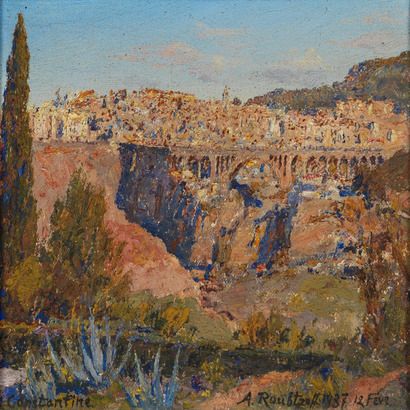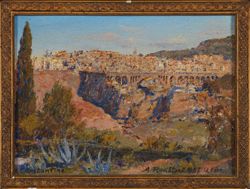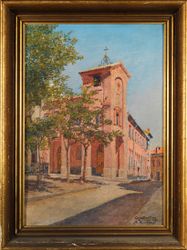Alexandre Roubtzoff
Born in St. Petersburg, January 24, 1884, Grand Prix of the Imperial Academy of Fine Arts of the same city in 1912 for his painting Interior Empire style (now in the Hermitage Museum), the Slav is forever seduced by the brightness of the country he discovered. But unlike the first orientalists who often made only a brief incursion into the East, he decided to stay. Tunisia offers him its light, "this infinite wealth of shades of white except for the absolute white which does not exist" as well as a repertoire of totally new subjects and it is with the bulimia of wonder that he will inventory every bit of this Tunisian life so "diametrically opposed to the European life". The abundance of subjects to paint and draw is such, he says, that he does not want to waste precious time shaving and he lets his beard grow: "From hairless in St. Petersburg, I become bearded in Tunis.
Solicited from all sides, Roubtzoff gives himself up in his drawings and paintings to a real exhaustive census of everything that makes up the Orient: old streets of the Medina, studded doors, souks, cafés, marabouts, scenes of daily life... Nothing escapes his subjugated gaze, not even the living antiquity that shines through in the costumes of the Arab populations. "Rome is no longer in Rome" according to the famous formula of Delacroix, but it is the great names of Greek sculpture that Roubtzoff cites to evoke the folds of burnous and other haiks: "Frozen in their sculptural and noble attitudes, they (the Bedouins) offer a harmony of folds and silhouettes of such beauty that it is towards them that Phidias, Praxiteles or Lysippus would have turned their gaze ... "
Very quickly this admiration is doubled by a deep awareness: "To save from oblivion the old modes of the East which are really beautiful". His fascination for the tattoos of the Bedouin women is thus nothing other than a desperate attempt to keep in memory the traces of an ancestral world that he knows is threatened. A favorite theme in his sketchbooks, but also in his more accomplished pen and pencil works, tattoos never cease to fascinate the artist to the point of writing several articles on the subject in the magazine "Tunisie". Of course, in front of this type of drawings which isolate an arm, a leg and refuse any anecdote, we quickly speak about realist orientalism or even ethnographic. There is certainly some of this in Roubtzoff's work, but he has not forgotten the human figure.
As proof, the portrait of Babiza, taken in 1944, whose steady gaze evokes the famous Bedouin pride. Or the face of this mother in Zohra and Salha who seems worried about being painted. Roubtzoff's interest in physiognomies and the expression of feelings is growing. If the first Orientalist paintings, contemporary with his arrival in Tunis, still gave a predominant place to jewelry and other accessories (Ouled-Naïl of Biskra, 1916, Messaouda the Bedouin, also 1916), or even the decor (Bournia, 1917), it is no longer the same from the twenties. To seize the intimacy of a being, of a face, of a people, here is henceforth what will preoccupy our painter and which transpires repeatedly at the sight of these works.
|
|




